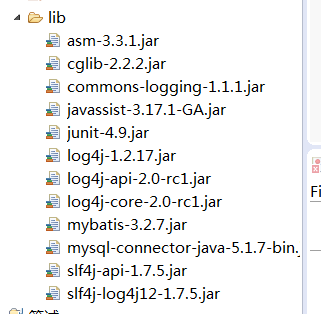MyBatis操作数据库——单表映射操作
- 建立一张表subjects,包含基本信息 subjects.sql
SET FOREIGN_KEY_CHECKS=0;
# ------------- subjects table --------------------
DROP TABLE IF EXISTS subjects;
CREATE TABLE subjects
(
id int NOT NULL ,
name varchar(20) NOT NULL ,
sex char(2) NULL ,
birthday char(50) NULL ,
age int NULL ,
id_card char(18) NULL ,
tel char(20) NULL ,
date char(50) NULL ,
height int NULL ,
weight int NULL ,
PRIMARY KEY (id)
) ENGINE=InnoDB DEFAULT CHARSET=utf8;
insert into subjects values(0,'被试0','女','19951003',20,'12345678901','18399992222','20161008',162,50);
insert into subjects values(1,'被试1','女','19951003',20,'12345678901','18399992222','20161008',162,50);- 新建 Java project,导入jar(myBatis\log4j\JUnit)包。

- 配置文件(log4j.properties\jdbc.properties)
注意:日志配置文件放在src根目录下,否则找不到;jdbc数据库连接配置信息中key-value中的value不要加“ ”; url后面要跟编码参数,否则中文编码会出错。
log4j.properies
# Global logging configuration
#\u5728\u5f00\u53d1\u73af\u5883\u4e0b\u65e5\u5fd7\u7ea7\u522b\u8981\u8bbe\u7f6e\u6210DEBUG\uff0c\u751f\u4ea7\u73af\u5883\u8bbe\u7f6e\u6210info\u6216error
log4j.rootLogger=DEBUG,stdout
# Console output...
log4j.appender.stdout=org.apache.log4j.ConsoleAppender
log4j.appender.stdout.layout=org.apache.log4j.PatternLayout
log4j.appender.stdout.layout.ConversionPattern=%5p [%t] - %m%njdbc.properties
jdbc.driver = com.mysql.jdbc.Driver
jdbc.url = jdbc:mysql://localhost:3306/数据库名字?useUnicode=true&characterEncoding=utf8
jdbc.username =root
jdbc.password =- 编写mysql_config.xml 主配置文件,config约束,jdbc连接。
<configuration>
<properties resource="config/jdbc.properties">properties>
<environments default="development">
<environment id="development">
<transactionManager type="JDBC" />
<dataSource type="POOLED">
<property name="driver" value="${jdbc.driver}" />
<property name="url" value="${jdbc.url}" />
<property name="username" value="${jdbc.username}" />
<property name="password" value="${jdbc.password}" />
dataSource>
environment>
environments>
<mappers>
<mapper resource="dao/subjectMapper.xml">mapper>
mappers>
configuration>- 创建subjectMapper.xml文件,mapper约束,在Mapper根标签中创建select标签 sql查询。(id,parameterType,resultType)
<mapper namespace="subject">
<select id="findById" parameterType="java.lang.Integer" resultType="model.Subject">
select * from subjects where id = #{id}
select>
<select id="findByName" parameterType="java.lang.String" resultType="model.Subject">
select * from subjects where name like "%被试%"
select>
mapper>- 因为select返回类型为对象,创建model.subject类。
package model;
public class Subject {
private int id;
private String name; //����
private String sex;
private String birthday;
private int age;
private String id_card; //���֤��
private String tel;
private String date; //�������
private int height;
private int weight;
public int getId() {
return id;
}
public void setId(int id) {
this.id = id;
}
//省略setter,getter
}- 编写Test类,通过JUnit注解@Test进行测试。
public class subjectMapperTest {
// 根据id查询被试,得到一条结果
@Test
public void findsubjectById() throws IOException{
//创建会话工厂
String resource = "config/mysqlMapper_config.xml";
InputStream inputStream = Resources.getResourceAsStream(resource);
SqlSessionFactory sessionFactory = new SqlSessionFactoryBuilder().build(inputStream);
SqlSession sqlSession = sessionFactory.openSession();
Subject sub = sqlSession.selectOne("subject.findById",1);
System.out.println(sub);
sqlSession.close();
}
}